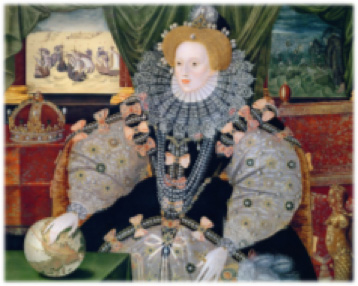We all know her famous quote when addressing the Troops at Tilbury, delivered on 19 August 1588 to the land forces earlier assembled at in preparation for repelling the expected invasion by the Spanish Armada.
I know I have the body of a weak and feeble woman, but I have the heart and stomach of a king, and of a King of England too.
The above portrait of Elizabeth was made to commemorate the defeat of the Spanish
Armada depicted in the background.
Elizabeth’s international power is symbolised by the hand resting on the globe.
Although she had many residences, Hampton Court did play significant role in her life.
Elizabeth I, like her father loved Hampton Court, despite having been held prisoner there shortly before her own accession. She often enjoyed relaxation from the cares of state at the palace. Records tell of her dancing, playing the virginals, watching entertainments in the Great Hall and flirting with her courtiers. She was resting in the gardens after the traditional goose banquet on Michaelmas Day, 1588, when a messenger brought her news of the defeat of the Spanish Armada.
It was also while staying at Hampton Court Palace that Elizabeth fell dangerously ill with smallpox, one of the deadliest diseases of the age.
She herself believed that she was dying and summoned a confessor. Meanwhile, her anxious councillors gathered to debate the vexed question of who should succeed her. In an age when male heirs were so hard to come by, both of the leading contenders were women: Mary, Queen of Scots and Katherine Grey, sister of the ill-fated Lady Jane. Much to everyone’s relief, Elizabeth recovered. She went on to become the longest-lived and longest-reigning of all the Tudors, and her ascendancy has been viewed as a ‘Golden Age’.
Elizabeth was also sensitive to smells. She especially hated kitchen odours, and as the privy kitchen, intended to serve royalty exclusively was beneath her apartments, she ordered new kitchens to be built in 1567. Now the Palaces’ public tea rooms.
Next time you visit see if you can find this trace of Elizabeth’s reign at the Palace. This date stone has
her initials and the date 1568, located on a window bay overlooking the gardens.

